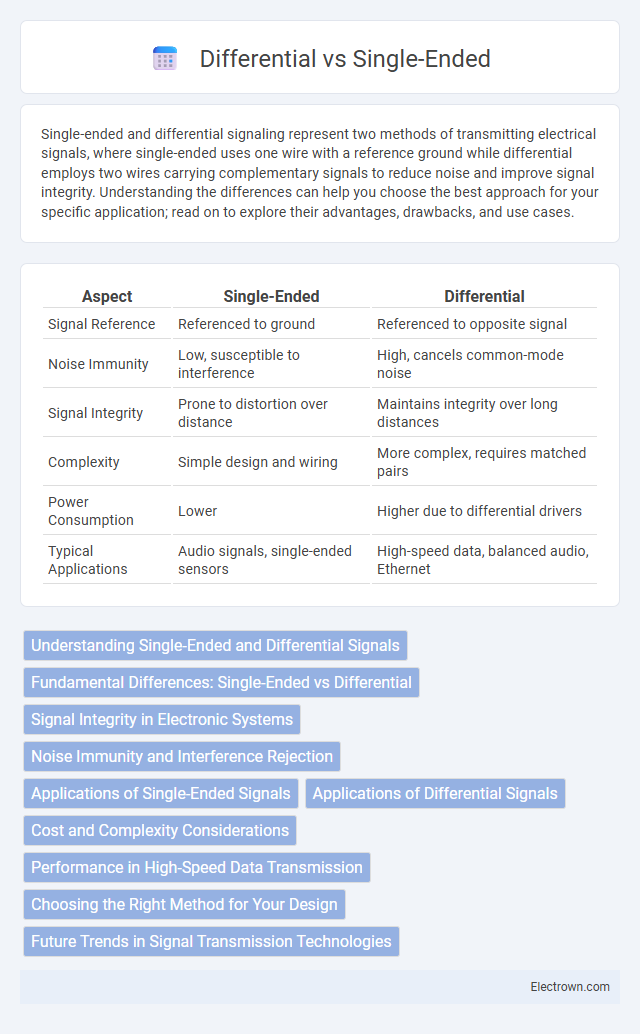Single-ended and differential signaling represent two methods of transmitting electrical signals, where single-ended uses one wire with a reference ground while differential employs two wires carrying complementary signals to reduce noise and improve signal integrity. Understanding the differences can help you choose the best approach for your specific application; read on to explore their advantages, drawbacks, and use cases.
Table of Comparison
| Aspect | Single-Ended | Differential |
|---|---|---|
| Signal Reference | Referenced to ground | Referenced to opposite signal |
| Noise Immunity | Low, susceptible to interference | High, cancels common-mode noise |
| Signal Integrity | Prone to distortion over distance | Maintains integrity over long distances |
| Complexity | Simple design and wiring | More complex, requires matched pairs |
| Power Consumption | Lower | Higher due to differential drivers |
| Typical Applications | Audio signals, single-ended sensors | High-speed data, balanced audio, Ethernet |
Understanding Single-Ended and Differential Signals
Single-ended signals use one conductor referenced to a common ground, making them simpler but more susceptible to noise and interference. Differential signals employ two complementary conductors carrying opposite voltages, enhancing noise immunity and signal integrity, especially in high-speed or long-distance communication. Understanding these differences helps you choose the appropriate signaling method to optimize performance in your electronic systems.
Fundamental Differences: Single-Ended vs Differential
Single-ended signals transmit data using one wire with a reference to ground, making them more susceptible to noise and interference. Differential signals use two complementary wires where the receiver measures the voltage difference, enhancing noise immunity and signal integrity. This fundamental difference results in differential signaling being preferred for high-speed or long-distance communication due to its robustness against electromagnetic interference.
Signal Integrity in Electronic Systems
Single-ended signals transmit data through one conductor referenced to a common ground, making them more susceptible to noise and electromagnetic interference, which can degrade signal integrity in electronic systems. Differential signaling uses two complementary signals transmitted over a pair of conductors, enhancing noise rejection and reducing electromagnetic emissions, thereby significantly improving signal integrity. This approach is essential in high-speed or sensitive applications, where maintaining data accuracy and minimizing errors is critical.
Noise Immunity and Interference Rejection
Differential signaling offers superior noise immunity and interference rejection compared to single-ended signaling by transmitting two complementary signals, allowing external noise to be canceled out at the receiver. Single-ended signals reference a common ground, making them more susceptible to electromagnetic interference and ground noise, which can degrade signal integrity. Choosing differential signaling for Your system enhances performance in electrically noisy environments by minimizing signal distortion and maintaining data accuracy.
Applications of Single-Ended Signals
Single-ended signals are widely used in applications such as audio equipment, microcontroller inputs, and sensor interfaces, where simplicity and cost-effectiveness are priorities. They are prevalent in consumer electronics, automotive systems, and low-speed digital communications due to their straightforward wiring and compatibility with standard components. Single-ended signaling suits environments with minimal electromagnetic interference, ensuring reliable data transmission in short-distance or less noise-sensitive conditions.
Applications of Differential Signals
Differential signals are widely used in high-speed data communication, such as USB, HDMI, and Ethernet interfaces, due to their superior noise immunity and signal integrity. Your critical applications in industrial automation, medical devices, and telecommunications benefit from differential signaling as it minimizes electromagnetic interference and crosstalk. This makes differential signaling ideal for environments where reliable and accurate data transmission is essential.
Cost and Complexity Considerations
Single-ended circuits offer lower cost and simpler design, making them ideal for basic applications with minimal interference concerns. Differential circuits, while more complex and expensive due to additional components and precise layout requirements, provide superior noise immunity and signal integrity in challenging environments. Understanding your project's budget and performance needs helps determine whether the cost and complexity of differential signaling are justified.
Performance in High-Speed Data Transmission
In high-speed data transmission, differential signaling offers superior noise immunity and reduced electromagnetic interference compared to single-ended signaling, making it ideal for maintaining signal integrity over longer distances and at higher frequencies. Single-ended signals are more susceptible to crosstalk and ground noise, which can degrade performance and limit data rates. Your choice between these methods directly impacts the reliability and speed of your communication system, especially in environments with significant electrical noise.
Choosing the Right Method for Your Design
Choosing between single-ended and differential signaling depends on your design's noise immunity requirements and signal integrity goals. Single-ended signals are simpler and cost-effective, ideal for short-distance or low-speed applications, while differential signaling excels in minimizing electromagnetic interference (EMI) and crosstalk for high-speed or long-distance transmissions. Understanding the trade-offs ensures you select the right method for optimal performance and reliability in your circuit design.
Future Trends in Signal Transmission Technologies
Future trends in signal transmission technologies emphasize increased adoption of differential signaling to enhance noise immunity and support higher data rates in communication systems. Innovations in low-power, high-speed interfaces are leveraging differential pairs to reduce electromagnetic interference (EMI) and improve signal integrity in complex electronic devices. Emerging applications such as 5G networks, autonomous vehicles, and IoT ecosystems drive the evolution of mixed-signal integrated circuits that prioritize differential signaling for robust, scalable connectivity solutions.
Single-Ended vs Differential Infographic

 electrown.com
electrown.com